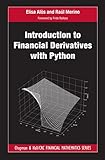Introduction to financial derivatives with Python / Elisa Alòs, Raúl Merino
Material type: TextSeries: Chapman & Hall/CRC Financial Mathematics SeriesPublisher: Baco Raton : CRC Press, 2023Description: 228 Pages : illustrations ; 25 cmISBN: 9781032211039; 9781003266730Subject(s): Derivative securities | Python (Computer program language)DDC classification: 332.64
TextSeries: Chapman & Hall/CRC Financial Mathematics SeriesPublisher: Baco Raton : CRC Press, 2023Description: 228 Pages : illustrations ; 25 cmISBN: 9781032211039; 9781003266730Subject(s): Derivative securities | Python (Computer program language)DDC classification: 332.64 | Item type | Current location | Call number | Status | Date due | Barcode |
|---|---|---|---|---|---|
| Books | Institute of Public Enterprise, Library S Campus | 332.64 ALO (Browse shelf) | Checked out | 02/22/2024 | 47793 |
Includes bibliographical references and index.
1. Introduction. 1.1. Financial Markets. 1.2. Derivatives. 1.3. Time has a Value. 1.4. No-Arbitrage Principle. 1.5. Chapter’s Digest. 1.6. Exercises. 2. Futures and Forwards. 2.1. Forward Contracts: Definitions. 2.2. Futures. 2.3. Why to use Forwards and Futures? 2.4. The Fair Delivery Price: The Forward Price. 2.5. Chapter’s Digest. 2.6. Exercises. 3. Options. 3.1. Call and Put Options. 3.2. The Intrinsic Value of an Option. 3.3. Some Properties of Option Prices. 3.4. Speculation with Options. 3.5. Some Classical Strategies. 3.6. Draw your Strategy with Python. 3.7. Chapter’s Digest. 3.8. Exercises. 4. Exotic Options. 4.1. Binary Options. 4.2. Forward Start Options. 4.3. Path-Dependent Options. 4.4. Spread and Basket Options. 4.5. Bermuda Options. 4.6. Chapter’s Digest. 4.7. Exercises. 5. The Binomial Model. 5.1. The Single-Period Binomial Model. 5.2. The Multi-Period Binomial Model. 5.3. The Greeks in the Binomial Model. 5.4. Coding the Binomial Model. 5.5. Chapter’s Digest. 5.6. Exercises. 6. A Continuous-Time Pricing Model. 6.1. Creating Some Intuition. 6.2. The Black-Scholes-Merton Framework. 6.3. THE BLACK-SCHOLES-MERTON EQUATION. 6.4. The Black-Scholes-Merton Formula. 6.5. The Black-Scholes-Merton Model from a Probabilistic Perspective. 6.6. The Black-Scholes-Merton Price and the Binomial Price. 6.7. The Greeks in the Black-Scholes-Merton Model. 6.8. Other Assets. 6.9. Drawbacks of the Black-Scholes-Merton Model. 6.10. Chapter’s Digest. 6.11. Exercises. 7. Monte Carlo Methods. 7.1. The Need of General Option Pricing Tools. 7.2. Mathematical Foundations of Monte Carlo Methods. 7.3. Option Pricing with Monte Carlo Methods. 7.4. European Options that Depend on the Final Price of Two Assets. 7.5. Chapter’s Digest. 7.6. Exercises. 8. The Volatility. 8.1. Historical Volatilities. 8.2. The Spot Volatility. 8.3. The Implied Volatility. 8.4. Chapter’s Digest. 8.5. Exercises. 9. Replicating Portfolios. 9.1. Replicating Portfolios for the Binomial Model. 9.2. Replicating Portfolios for the Black-Scholes-Merton Model. 9.3. Chapter’s Digest. 9.4. Exercises.
"Introduction to Financial Derivatives with Python is an ideal textbook for an undergraduate course on derivatives, whether on a finance, economics, or financial mathematics programme. As well as covering all of the essential topics one would expect to be covered, the book also includes the basis of the numerical techniques most used in the financial industry, and their implementation in Python. Features Connected to a Github repository with the codes in the book. The repository can be accessed at https://bit.ly/3bllnuf Suitable for undergraduate students, as well as anyone who wants a gentle introduction to the principles of quantitative finance No pre-requisites required for programming or advanced mathematics beyond basic calculus"--


There are no comments on this title.